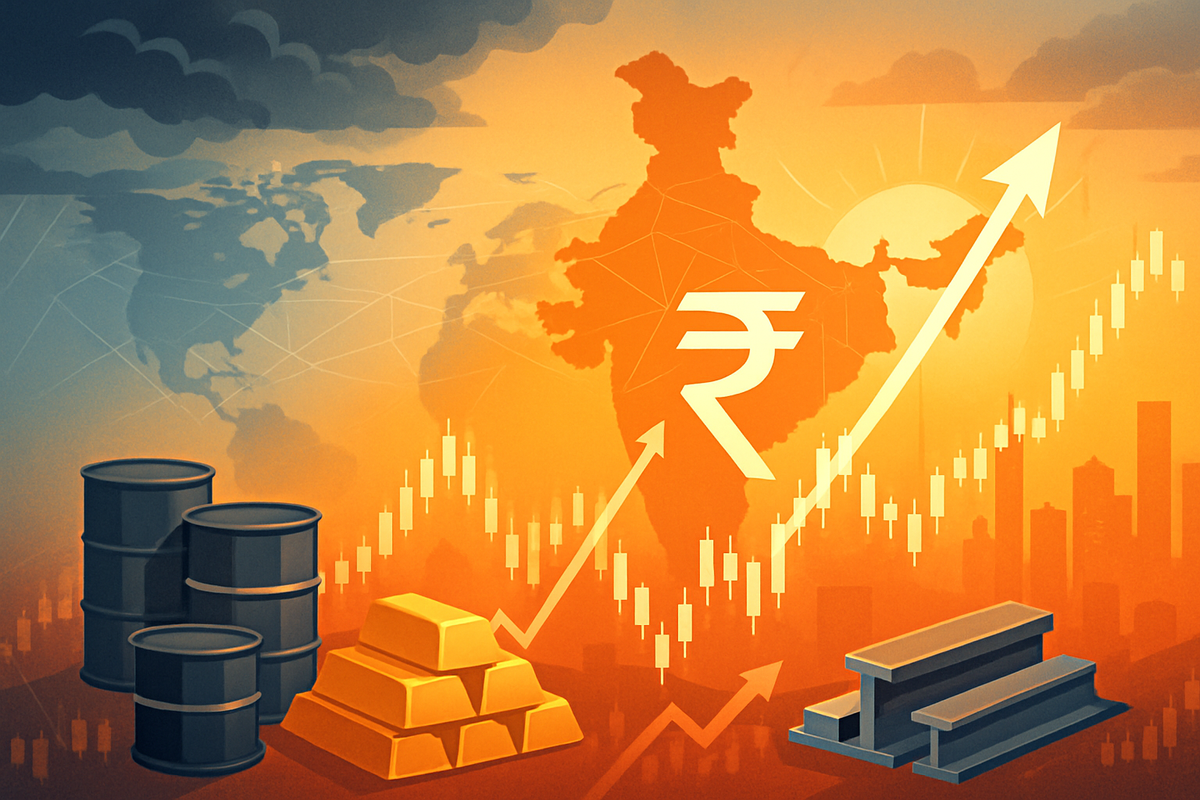
India's economic narrative in late 2025 is increasingly defined by a complex interplay of global macroeconomic forces rather than solely by escalating trade tensions with the United States. While the imposition of significant US tariffs has undeniably cast a shadow, a broader assessment reveals that factors such as volatile commodity prices, global trade dynamics, and the ongoing corporate earnings cycle are posing more profound risks and shaping the nation's financial landscape. Despite these challenges, recent Q1 FY26 corporate results have shown surprising resilience, hinting that the worst of the earnings downgrade cycle may be behind, even as the full recovery remains a work in progress.
This evolving scenario underscores India's growing integration into the global economy, where domestic strength must continually contend with external pressures. The focus has shifted from bilateral trade disputes to the more pervasive influence of international economic trends, demanding a nuanced understanding of their impact on India's growth trajectory, inflation outlook, and corporate profitability.
The Earnings Cycle's Turn: Resilience Amidst Headwinds
The Indian corporate sector has been grappling with a prolonged earnings downgrade cycle, a period where analysts consistently revise down their profit expectations for companies. However, recent developments suggest a potential inflection point. As Himanshu Kohli, a notable market analyst, indicated, "The earnings downgrade cycle hasn't fully concluded, but the worst may be behind as Q1 FY26 results demonstrated surprising resilience." This assessment, made in the context of the April-June 2025 quarter (Q1 FY26), provides a crucial insight into the current economic climate.
India's Q1 FY26 saw robust GDP growth of 7.8%, a figure driven by strong private consumption, increased investment, and sustained government spending. A favorable monsoon season and the positive effects of Goods and Services Tax (GST) rationalization further bolstered this performance. While the September 2025 quarter (Q2 FY26) is anticipated to show more modest growth in net profits for the Nifty 50, estimated at around 6-7% year-on-year, primarily propelled by sectors like oil & gas, metals, and cement, the outlook beyond this period appears more optimistic. Analysts widely expect double-digit earnings growth to resume from Q3 FY26 onwards, supported by low base effects from previous quarters, improving high-frequency economic indicators, continued government expenditure, and a consumption boost from recent GST rate cuts. The share of stock downgrades in Q1 FY26 was reportedly the lowest in the past year, particularly for large-cap companies, lending credence to the view that the earnings cycle is stabilizing.
This domestic resilience is particularly significant when juxtaposed against the backdrop of escalating US-India trade tensions. The Trump administration's imposition of a 25% "reciprocal" tariff on Indian exports in August 2025, followed by an additional 25% penalty related to India's continued imports of Russian oil, brought the total duty to a substantial 50%. While this has undeniably created headwinds for export-oriented sectors, India's proactive measures, including accelerating export market diversification through pacts like the India-European Free Trade Association (EFTA) agreement (effective October 1, 2025) and domestic GST reductions, aim to mitigate the impact. These actions highlight a strategic pivot towards strengthening internal demand and finding alternative global markets, thereby reducing vulnerability to bilateral disputes.
Navigating the Winners and Losers in a Shifting Landscape
The current economic environment, characterized by global macroeconomic shifts and commodity price volatility, creates distinct winners and losers across India's corporate landscape. Companies with strong domestic demand exposure and those benefiting from strategic government policies are poised for growth, while export-heavy sectors facing tariff barriers and industries sensitive to input cost fluctuations face challenges.
On the winning side, sectors that benefit from lower crude oil prices, such as airlines like IndiGo (NSE: INDIGO) and logistics companies, stand to gain significantly, given India's heavy reliance on oil imports. The projected average of $65-$70 per barrel for crude in FY26, alongside easing food prices and GST rationalization, contributes to lower inflation and a smaller current account deficit, fostering a more conducive environment for domestic consumption. Companies in the consumer discretionary space, buoyed by the government's September 2025 GST cuts on numerous goods and robust private consumption, are also likely beneficiaries. Furthermore, sectors like oil & gas, metals, and cement, which demonstrated strong performance in Q2 FY26, are expected to continue their positive trajectory. Companies actively pursuing export market diversification, particularly those targeting European markets through the EFTA pact, could also find new avenues for growth.
Conversely, export-oriented sectors heavily reliant on the US market are likely to face significant headwinds due to the steep 50% tariffs. While specific companies weren't named in the research, industries such as textiles, pharmaceuticals, and certain IT services providers with high US exposure would need to recalibrate their strategies. The IT sector, along with some banks, is also facing sector-specific challenges, including net interest margin compression for banks, which could lead to further earnings cuts. In the industrial commodities space, while manganese ore prices have risen due to supply disruptions, manganese alloy producers, including many Indian smelters, are struggling with weak demand from domestic steel mills and overseas buyers, leading to production cuts and losses. This highlights how rising input costs coupled with weak demand can squeeze profitability, making these companies potential losers in the current climate.
Wider Significance: India's Economic Resilience and Strategic Evolution
The current economic scenario in India extends beyond immediate market reactions, revealing deeper trends and strategic shifts within the nation's economic framework. The emphasis on macroeconomic factors over bilateral tensions highlights India's increasing maturity as a global economic player, capable of absorbing shocks while strategically adapting.
One significant broader industry trend is India's pivot towards strengthening domestic demand as a primary growth engine. The robust private consumption and government spending witnessed in Q1 FY26, coupled with strategic GST reductions, underscore a conscious effort to insulate the economy from external volatility. Simultaneously, the aggressive pursuit of export market diversification, exemplified by the EFTA pact, reflects a strategic evolution aimed at reducing over-reliance on any single trading partner and building a more resilient export base. The potential shift towards a greater share of domestic coal in India's energy mix to reduce import reliance also indicates a move towards greater energy security amidst global energy price fluctuations.
Regulatory and policy implications are profound. The Reserve Bank of India (RBI) has played a crucial role in maintaining stability, not only through its monetary policy but also through reforms aimed at strengthening the external sector, such as easing foreign exchange compliance for small exporters and promoting the internationalization of the Indian Rupee (INR). The government's fiscal policies, including GST rationalization and targeted spending, are critical in supporting domestic growth and mitigating the impact of external pressures. Historically, India has demonstrated considerable resilience in navigating global economic headwinds, often leveraging its large domestic market to cushion external shocks. This current period, while challenging, aligns with past instances where India has adapted its economic policies to maintain growth amidst global uncertainties, suggesting a continuation of this adaptive approach.
What Comes Next: A Path of Cautious Optimism and Strategic Adaptation
Looking ahead, India's economic trajectory will be shaped by a confluence of short-term challenges and long-term strategic opportunities. The immediate future demands vigilance, particularly concerning global trade dynamics and commodity price movements, while the long-term outlook points towards continued growth, albeit with necessary adaptations.
In the short term, market participants will closely monitor the evolution of global trade tensions, especially the duration and impact of US tariffs, and India's success in diverting exports to new markets. Commodity prices, particularly crude oil, will remain a critical variable, with any significant spikes posing renewed inflationary pressures. The stability of the Indian Rupee (INR), which has seen some pressure (averaging around ₹88.32/USD in September 2025), will also be a key indicator. The progression of the corporate earnings recovery, particularly the confirmation of double-digit growth from Q3 FY26, will be crucial for market sentiment. Potential strategic pivots will include further efforts by businesses to localize supply chains, diversify customer bases, and enhance operational efficiencies to counter rising costs and trade barriers.
For the long term, India's fundamental growth drivers, including its large and young population, increasing urbanization, and ongoing infrastructure development, remain intact. The government's continued focus on fiscal consolidation and structural reforms is expected to bolster economic resilience. Market opportunities may emerge in sectors benefiting from increased domestic consumption, renewable energy, and digital transformation. Challenges will persist from sustained global trade protectionism and potential global economic slowdowns. Scenarios could range from a relatively smooth recovery driven by domestic demand and successful export diversification to a more protracted period of moderate growth if external headwinds intensify significantly.
Comprehensive Wrap-up: Resilience as the Defining Theme
In summary, while geopolitical tensions with the United States certainly present a notable external challenge, the overarching narrative for India's economy in late 2025 is increasingly dominated by broader macroeconomic factors. The resilience demonstrated in Q1 FY26 corporate earnings, driven by strong domestic fundamentals, suggests that the worst of the earnings downgrade cycle may be past, paving the way for a gradual recovery. However, the influence of global commodity price volatility, particularly crude oil and precious metals, alongside the imperative for export diversification, remains paramount.
Moving forward, the Indian market will likely exhibit cautious optimism. The nation's ability to maintain contained inflation, manage its current account deficit, and implement strategic policy responses—such as GST cuts and export market diversification—underscores its inherent strength. Investors should closely watch key indicators including global trade data, inflation trends, the Reserve Bank of India's monetary policy decisions, and, crucially, corporate earnings reports for confirmation of the anticipated recovery. The strategic adaptation of Indian businesses and policymakers to a complex global environment will be the defining theme in the coming months, solidifying India's position as a resilient and dynamically evolving economy.
This content is intended for informational purposes only and is not financial advice





